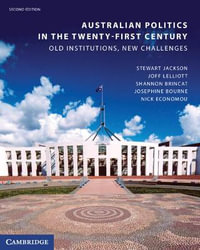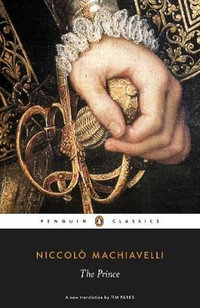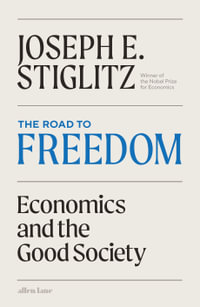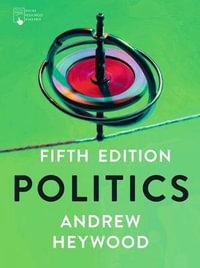
At a Glance
322 Pages
19.2 x 23.6 x 2.1
Paperback
$149.81
or 4 interest-free payments of $37.45 with
orAims to ship in 7 to 10 business days
"At long last, a text that puts science back into political science; at the same time, it is not an 'American government and politics' text masquerading as an introduction to political science. I am delighted with it. The central concept of the 'public good' lends coherence to the organization of the book and allows Josep M. Colomer to integrate a vast amount of material encompassing all levels of analysis. The product is a remarkable achievement."-Abdalla Battah Minnesota State University Mankato
"The Science of Politics: An Introduction aims to do something that no other political science textbook currently does: to lay out the key 'things we know' about politics that satisfy the criteria of simplicity, practicality, and historical relevance. It is very well written, with an authoritative style that clearly demonstrates an impressive sweep of historical knowledge and understanding...It has an analytical coherence that is consistent throughout the book, in line with the goal to be 'scientific.' This style completely distinguishes this text from others in the field and is a key selling point for students. I would recommend it to others without hesitation"-Helen Margetts University of Oxford.
A broad, accessible, and rigorous overview of politics, The Science of Politics: An Introduction introduces students to the most substantive and important issues in the field. Josep M. Colomer takes a unique approach to the study of politics, addressing it from two points of departure: as a fundamental human activity to pursue the common interests of the members of a community (i.e., the "public good") and as the subject of systematic and reliable knowledge (i.e., science). This method helps to bridge a persistent gap between developments in research and actual teaching in the discipline. It provides students with the best possible foundation to build upon as they move into more advanced study in the field.
Features
Presents thirty principles that have been established through research over the years
Gives students the methodological tools to explore, study, and understand questions and issues that they may encounter
Discusses a variety of key issues including action, representation, government, and policy
Incorporates a number of pedagogical devices including summaries, key concepts, review questions, problems and applications, comparative case studies, and special features explaining classic research contributions
Industry Reviews
SOME THINGS WE KNOW Thirty Propositions in Political Science
I. ACTION
1. THE PUBLIC GOOD Public Goods Indivisibility Externalities Source 1.1: Private Goods and Public Goods Types of Public Goods Pure Public Goods Club Goods The Commons Source 1.2: The Tragedy of the Commons The Politics of Public Goods Redistribution Fights The Growth of Public Expenditure Box 1.1: Measuring Government's Action
2. COLLECTIVE ACTION The Individual Logic Weighed Benefits and Costs The Free Rider Selective Incentives Exit and Voice Case 2.1: Benefits and Costs of Voting Sources 2.1: The Individual Logic of Collective Action The Size of the Group Types of Groups Collective Identity Exploitation of the Large by the Small Sources 2.2: Small Groups Get Better Organized
3. COOPERATION AND CONFLICT The Prisoner's Dilemma Cooperate and Defect Other Political Dilemmas Box 3.1: Going for the Blonde Case 3.1: Prisoner's Dilemma in the Opera Sources 3.1: Theory of Games The Evolution of Cooperation Tit for Tat Indefinite Plays Favorable Contexts Other Games of Collective Action Chicken Stag Hunt Box 3.2: Basic Games Sources 3.2: Chickens and Stags
4. LEADERSHIP What is a Leader? Leaders' Benefits and Opportunity Costs Leaders' Personal Skills Cases 4.1: Some Top Leaders Sources 4.1: Effective Leadership Leaders and Followers The Chain Reaction The Tipping Game Box 4.1: Tipping Game of Leadership Institutions for Leadership Willing Leaders Reluctant Leaders Group Asymmetries Illustration Public Expenditure, 1870-2005
II. POLITY
5. COMMUNITY Multilevel Governance The Scale of Public Goods Complex Institutions Box 5.1: The Subsidiarity Criterion Case 5.1: Local Self-Government in Renaissance Italy Sources 5.1: Small is Democratic Sovereignty State-Building and Nation-Building State-War Making State-Failure Sources 5.2: National and Multinational States City, State, Empire City State Empire
6. FEDERATION The Size of The Community Democratic Benefits Economic Efficiency Size and Democracy Union Ethnic Variety Divided Institutions The Choice of Federalism Box 6.1: Measuring Ethnic Variety Case 6.1: Consensual Switzerland Case 6.2: The Soviet Disunion Sources 6.1: Self-Government and Union
7. DICTATORSHIP Forms of Dictatorship Totalitarianism Despotism Authoritarianism Cases 7.1: The Dictator's Succession Sources 7.1: Authoritarian and Totalitarian Dictatorships The Fall of Dictatorships Revolution and Civil War Democratization Case 7.2: Must Islam Be Associated with Dictatorship?
8. DEMOCRACY What's Democracy? Overthrowing the Rulers Consolidation Box 8.1: Measuring Democracy Box 8.2: Democracy and Dictatorship in the World Sources 8.1: Civic Culture Democracy and Development Development Favors Democracy Democracy Favors Development Box 8.3: Economic Wealth and Political Regime Cases 8.1: Democratic India, Dictatorial China Sources 8.2: Socio-Economic Correlations with Political Democratization Democratic Peace Peace for Votes Peace Favors Democracy Illustration Country-Building, 1870-2008 Democracy and Dictatorship, 1870-2008
III. ELECTION
9. POLITICAL PARTIES Why Parties Formation of Political Parties Functions of Parties Types of Parties Party Members Two-Level Games Party Types Box 9.1: Extreme Activists Case 9.1: How the UK's Labour Choose Candidates Source 9.1: The Political Oligarchy
10. ELECTORAL COMPETITION The Voters Individual Preferences The Voter's Utility Function Collective Distributions of Preferences Box 10.1: Party Voting and Issue Voting Sources 10.1: Elections as Markets Convergence on the Median Voter Electoral Equilibrium The Efficient Median Voter Sources 10.2: The Median Voter Maximizes Social Utility The Incumbent's Advantage Governments Win and Lose Elections Party Identification Box 10.2: Measuring Electoral Change Box 10.3: Mathematics of Voting
11. AGENDA FORMATION Multiple Issues Individual Indifferences The Winning Set Case 11.1: Electoral Competition in the United States Sources 11.1: Multidimensional Instability Setting The Agenda Party Advantage on Issues Electoral Campaigns Cumulative Policy Making Cases 11.2: Electoral Issues in TV Ads Sources 11.2: Political Arguments
12. PARTY SYSTEMS Number of Parties Numbers of Issues and Parties Ideology What's an Ideology? The Left-Right Ideological Dimension Polarization vs. Consensus Box 12.1: Measuring Party Systems Case 12.1: Swing Political Parties Source 12.1: Types of Party Systems Illustration Government Parties, 1945-2005
IV. GOVERNMENT
13. CHOOSING PRESIDENTS Unanimity Unanimous Consent Advantage of the Status-Quo Majority The Median Voter's Majority Majority-Runoff Plurality Comparing Majority Runoff and Plurality Rules The Choice of Majority Rules Box 13.1: The 'Impossibility' to Be Fair Box 13.2: Majority Procedures Case 13.1: Divide and Win in Black and White Sources 13.1: The Majority is the Whole
14. ELECTING ASSEMBLIES Assembly Size Large Countries, Large Assemblies Seat-Apportionment Persons and Parties Community Voting Single-Seat Districts Proportional Representation Electoral Representation Party Representation Personal Representation Box 14.1: Proportional Quotas Box 14.2: Measuring Proportionality Case 14.1: Protective Proportional Representation Cases 14.2. Single-Seat and Multi-Seat Ballots Sources 14.1: The Chicken and the Egg
15. DIVISION OF POWERS Assemblies and Presidents Parliamentary Regime Presidential Regime Box 15.1: Three Assemblies Parliamentary Regime Single-Party Parliamentarism Multiparty Parliamentarism Case 15.1: Ceremonial Chief of State Presidential Regime Checks and Balances Presidentialism Semi-Presidentialism Box 15.2: Concentration of Power Sources 15.1: The Presidentialist Temptation
16. PARTY GOVERNMENT Single-Party and Multi-Party Government Appointing the Government Office and Policy Power Distribution Cabinet Duration Box 16.1: Forming a Winning Coalition Case 16.1: The Importance of Being Not Too Many Unified and Divided Government Divided Elections Legislative Process Presidential and Congressional Dominance Multiparty Presidents Illustration Assembly Electoral Systems, 1870-2008 Political Regimes, 1870-2008
FINAL THOUGHTS FURTHER READING KEY CONCEPTS POLITICAL THINKERS CREDITS INDEX
ISBN: 9780195397741
ISBN-10: 0195397746
Series: Sinauer
Published: 1st July 2010
Format: Paperback
Language: English
Number of Pages: 322
Audience: College, Tertiary and University
Publisher: Oxford University Press USA
Country of Publication: GB
Dimensions (cm): 19.2 x 23.6 x 2.1
Weight (kg): 0.58
Shipping
| Standard Shipping | Express Shipping | |
|---|---|---|
| Metro postcodes: | $9.99 | $14.95 |
| Regional postcodes: | $9.99 | $14.95 |
| Rural postcodes: | $9.99 | $14.95 |
How to return your order
At Booktopia, we offer hassle-free returns in accordance with our returns policy. If you wish to return an item, please get in touch with Booktopia Customer Care.
Additional postage charges may be applicable.
Defective items
If there is a problem with any of the items received for your order then the Booktopia Customer Care team is ready to assist you.
For more info please visit our Help Centre.























